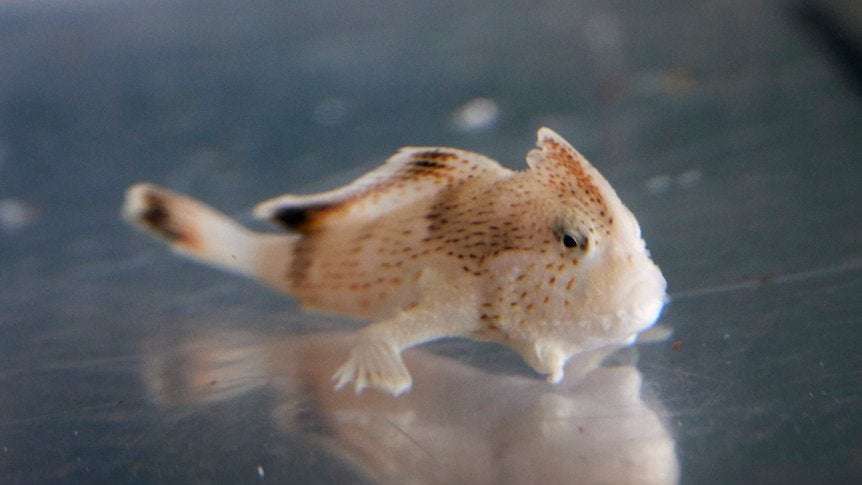A critically endangered fish from Tasmania has been given a boost in its odds for survival through a successful breeding effort interstate.
Key points: The critically endangered spotted handfish has been bred in captivity for the first time outside Tasmania
The critically endangered spotted handfish has been bred in captivity for the first time outside Tasmania The baby handfish hatched more than a year ago and are now ready for display at Melbourne's aquarium
The baby handfish hatched more than a year ago and are now ready for display at Melbourne's aquarium It's hoped there will eventually be enough bred to return some to the wild
Endemic to the island state, the spotted handfish is known for its preference of walking on hand-like pectoral fins across the seabed rather than swimming, and has become a big focus of marine conservation efforts.
Once found across Tasmania, this particular handfish's wild population can now only be found in a handful of spots in the River Derwent and at location in the D'Enctrecasteaux Channel.
But, over in Melbourne, the team at the SeaLife Aquarium is doing it's part to help boost numbers — successfully breeding a small number of the species.
Lead aquarist Sam Fawke said the feat was "extremely exciting."
"Originally we only planned on having them here as an ambassador population to educate the public — and then successfully managed to get them to breed and now we're a key part of this whole program.
The spotted handfish is only found in a few spots in Tasmania. ( Supplied: Sea Life Melbourne Aquarium )
"It should be really awesome to see this new population flourish."
The babies, known as fry, were hatched in January last year, and have been spending their time since growing and developing in nursery aquariums in the facility's back of house.
But now, they're ready to take centre stage.
"This is an incredible step forward for the program, and a major achievement for the team," Mr Fawke said.
"We've only got a small population on-site at this point in time — there are 10 on display.
Get Tas alerts on the ABC News app Here are the steps to get breaking news alerts on the latest Tasmanian stories directly to your phone. 📱 Download the ABC News app — Apple App Store | Google Play
"But we do have a population back of house as well that are currently being reared as an ambassador population that we hope to house at a sister site either at Sydney or Mooloolaba."
It's been no small effort to get to this stage, with the aquarium having established its breeding program in late 2017 through their involvement with the Handfish Conservation Project — alongside CSIRO and Seahorse World in northern Tasmania.
From there, the aquarium team worked to replicate the handfish's environmental conditions in the wild, including changes in temperature, food availability and lighting and salinity levels — to get conditions just right for breeding.
"It was quite tedious," Mr Fawke said. "It took us a few years to get it right.
"We're quite confident that we should be able to breed them moving forward.
Researchers are celebrating the milestone, saying it brings hope for the species' survival. ( ABC News )
"We have all of the right parameters in place and we know the trigger points now, so we shouldn't have any issues once these juveniles get to adults, or if we manage to source some more adults from the wild potentially in the future."
It's hoped the aquarium population will eventually breed, with ambitions of eventually being able to release some of the handfish back into wild Tasmanian waters.
All hands on deck approach needed
CSIRO science technician Tim Fountain, who is involved with the spotted handfish conservation efforts in Tasmania, said being in a position to release captive-bred handfish into the wild was a situation researchers were eagerly awaiting.
However, he said every step taken to bring awareness to the species along the way — and breeding successes like these — played a vital role.
The Melbourne team had to exactly replicate conditions that occur in the wild. ( Supplied: CSIRO Carlie Devine )
"It's a really important part," he said. "It's very hard to raise public awareness.
"The other thing is ... without the help from SEA LIFE it's very hard to get funding for these projects, even though they are quite important.
He said it there were sometimes long periods without significant progress and achievements like this were worth celebrating.
"We'll be hoping to use that experience that we've gained to produce more, hopefully, and make some more progress," he said.

Lilka333 on January 11st, 2023 at 13:21 UTC »
They look like pissed off Pokemon. I want seven.
sakela on January 11st, 2023 at 13:14 UTC »
What a cutie
Toosalty on January 11st, 2023 at 05:43 UTC »
I see a baby bird, on its back, …dramatically holding its arms out..